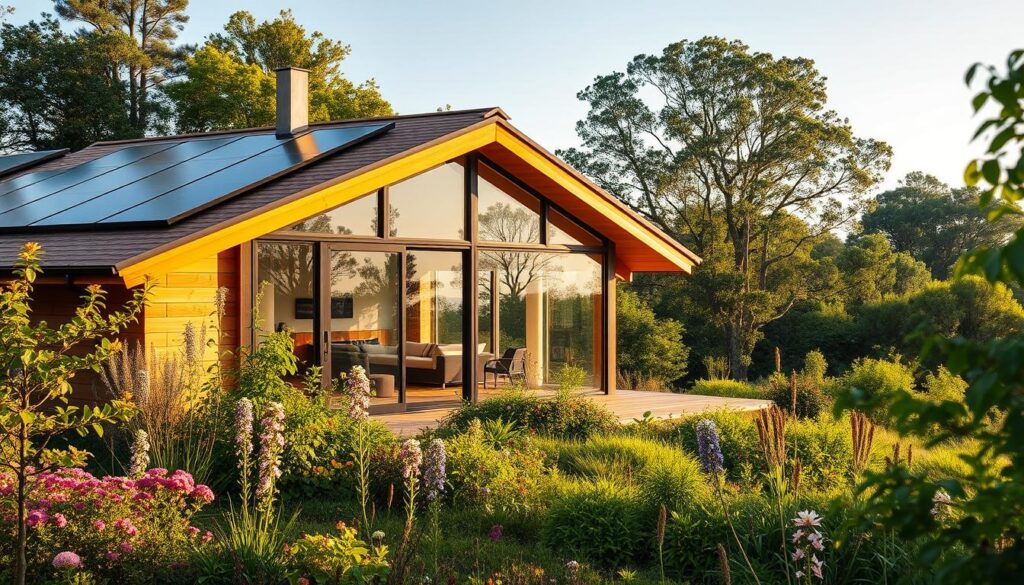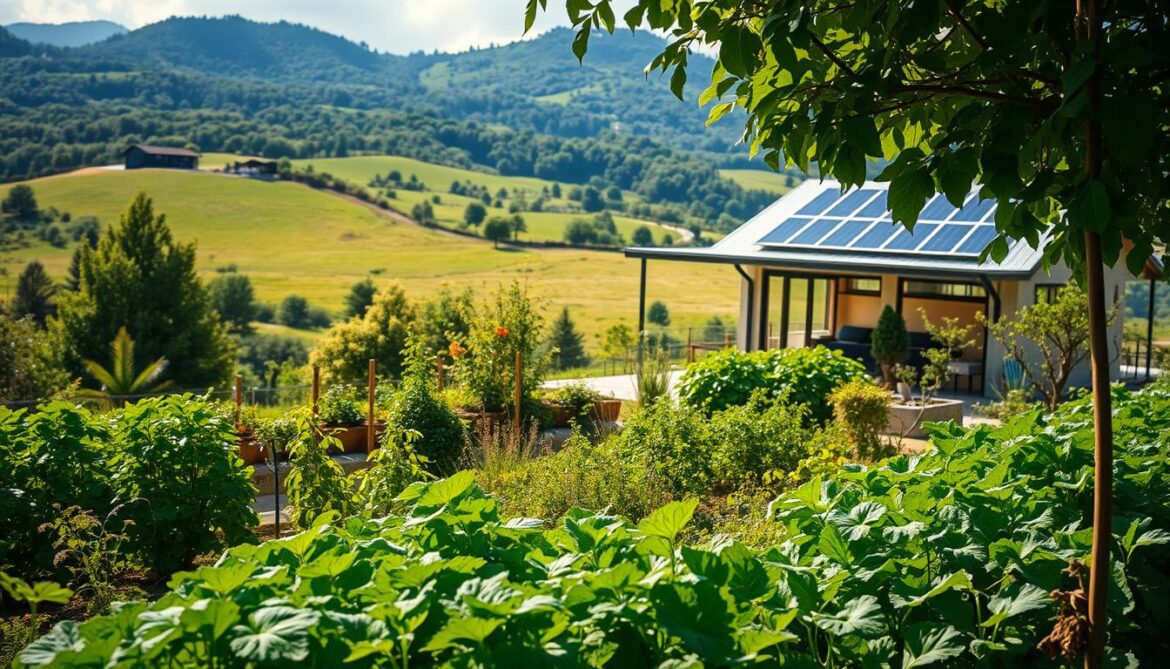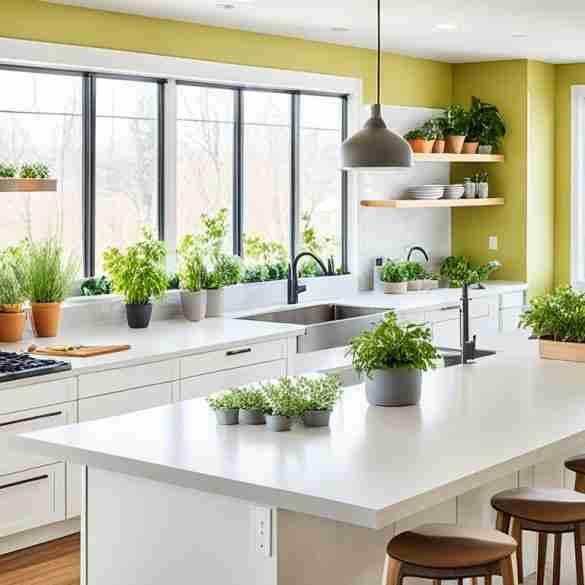Did you know households in Queensland waste enough energy annually to power 1.2 million refrigerators? This startling fact from Conservation International shows how small daily choices shape our carbon footprint. But here’s the good news: simple swaps, like switching to LED bulbs, can cut home energy use by 75%—saving both the planet and your wallet.
Creating an eco-friendly home doesn’t require drastic overhauls. For example, air-drying clothes just six months a year slashes dryer-related carbon emissions by 50%. These measurable wins add up: Sustainable Home Magazine found families using reusable bags and wraps reduce plastic waste by 1.3 tons over a decade.
We’ll explore realistic strategies—from water-saving showerheads to rechargeable batteries—that make sustainability achievable. You’ll discover how minor tweaks protect environmental resources and boost long-term savings. Let’s build habits that leave a healthier world for future generations—starting today.
Table of Contents
Key Takeaways to Defining Green Living: Practical Steps for Queenslanders
- LED bulbs reduce home energy use by up to 75% compared to traditional lighting.
- Air-drying clothes half the year cuts dryer-related carbon emissions by 50%.
- Reusable shopping bags can prevent 1.3 tons of plastic waste per household over 10 years.
- Eco-friendly changes often pay for themselves through utility bill savings within 2 years.
- Queensland households collectively waste energy equivalent to 1.2 million refrigerators annually.
Understanding the Concept of Green Living
How much difference can one household really make in combating climate change? Consider this: The average family creates 48 tons of carbon footprint annually through daily routines. But here’s the twist—sustainable living turns these statistics around through intentional choices that protect resources.
More Than Just a Trend
Green living means making decisions that preserve natural systems while meeting human needs. Conservation International reports simple swaps—like installing low-flow showerheads—can save 2,700 gallons of water yearly per home. That’s enough to fill 40 bathtubs!
Benefits multiply when communities act together. Sustainable Home Magazine found neighborhoods using reusable bags cut plastic waste by 58% within two years. You’ll also notice financial perks: Energy Star-certified appliances slash energy bills by $450 annually on average.
Daily Actions, Bigger Impact
Your thermostat holds surprising power. Lowering it just 3°F in winter reduces heating emissions by 5%—equivalent to planting 12 trees. At work, switching to digital documents saves 6.5 pounds of paper monthly per employee.
Smart habits create ripple effects. Recycling one aluminum can saves enough energy to power a TV for three hours. These choices don’t require sacrifice—they build smarter systems that protect air quality and future generations.
The Importance of Sustainable Home Practices in Queensland
Imagine cutting your home’s energy bills by 30% while shrinking your environmental impact—all through simple upgrades. Queensland’s subtropical climate makes smart home improvements particularly effective, with proper insulation alone reducing cooling needs by up to 40% during summer months.

How Home Improvements Impact Carbon Footprints
Switching to energy-efficient fixtures creates immediate wins. A Brisbane family recently slashed their carbon emissions by 1.2 tons annually just by installing LED lighting and smart power strips. These changes typically pay for themselves in under 18 months through energy savings.
Traditional homes waste resources daily. The Australian Sustainable Homes Report found inefficient properties use 50% more water and produce 3x more construction waste than eco-retrofitted counterparts. Simple fixes matter:
- Low-flow showerheads save 2,000+ gallons yearly
- Double-glazed windows cut heating costs by 25%
- Solar hot water systems reduce grid reliance by 60%
These upgrades also support local biodiversity—native plant landscaping reduces irrigation needs while providing wildlife habitats. You’ll notice fewer trips for maintenance supplies too, lowering transportation-related emissions.
Start with weather-stripping doors this weekend, then tackle attic insulation next month—consistent small steps yield measurable results.
Defining Green Living: Practical Steps for Queenslanders
Ready to make eco-changes but unsure where to start? Sustainable Home Magazine reveals 73% of homeowners see results within 90 days by focusing on three key areas: energy efficiency, waste reduction, and smarter daily habits. Let’s break down immediate actions that deliver measurable benefits.
Essential First Moves for Eco-Friendly Changes
Begin with your light switches. Replacing five traditional bulbs with LED alternatives cuts annual energy use by 450 kWh—enough to charge a smartphone for 34 years. Pair this with a programmable thermostat: lowering temperatures 7°F overnight reduces heating consumption by 10% (Sustainable Home Magazine, 2023).
| Action | Traditional Item | Eco Swap | Annual Impact |
|---|---|---|---|
| Lighting | 60W incandescent | 9W LED bulb | $85 savings |
| Hydration | Plastic bottles | Reusable tumbler | 156 lbs plastic avoided |
| Cleaning | Chemical sprays | Vinegar solution | 22 gallons water conserved |
Incorporating Local Sustainable Home Magazine Insights
Queensland’s Recycling Revival initiative shows how small tweaks create big shifts. Separating food scraps for compost diverts 400+ pounds of waste yearly from landfills—equivalent to removing a compact car from roads. The magazine’s 2024 study found using bamboo towels instead of paper products saves 17 trees per household over a decade.
Try these tomorrow: Fix leaky faucets (saves 10,000+ gallons water annually) and switch computers to sleep mode after 15 minutes (cuts office energy use by 30%). As Sustainable Home Magazine notes: “Every eco-swap is a vote for the nature we want to preserve.”
Energy Efficiency and Home Improvements for a Greener Queensland
What if your windows could slash your energy bills while protecting the planet? Queenslanders upgrading to double-glazed panes report 35% less heat transfer—saving 1.8 tons of carbon emissions yearly per home. This proves eco-upgrades aren’t just eco-friendly—they’re wallet-friendly too.

Smart Lighting and Appliance Upgrades
Swap outdated tech for smarter alternatives. A Gold Coast family cut their energy usage by 40% using:
- Wi-Fi-enabled thermostats adjusting temps automatically
- LED bulbs lasting 25x longer than incandescent
- Energy Star-rated refrigerators using 15% less power
Their secret? Prioritizing upgrades with quick payback periods. Smart power strips eliminated $127/year in vampire energy drain from idle devices.
Exploring Solar Panels and Renewable Energy Options
Queensland’s sunny climate makes solar a no-brainer. The Clean Energy Council reports rooftop systems here generate 62% more power than national averages. A 6kW system typically:
| Metric | Before Solar | After Solar |
|---|---|---|
| Grid Reliance | 100% | 38% |
| Annual Savings | $0 | $1,840 |
| CO2 Reduction | 6.2 tons | 2.3 tons |
Pair panels with battery storage to maximize returns. Brisbane’s Solar Citizens initiative shows homes storing excess power reduce emissions by 72% compared to grid-only setups.
Choose materials built to last—like stainless steel coffee cups replacing 500 disposable ones yearly. These practical investments protect resources for future generations while proving sustainable living saves money and the world.
Water Conservation and Waste Reduction Techniques
What if your shower and trash bin could team up to fight climate change? Everyday water use and waste habits quietly shape your environmental impact. A leaky toilet wastes 200 gallons daily—enough to fill three bathtubs—while improper recycling sends reusable materials to landfills.
Implementing Water-Saving Fixtures
Start with your bathroom. Low-flow showerheads save 2,900 gallons of water yearly per person while cutting energy use by 330 kWh (Queensland Water Commission). Pair them with faucet aerators to reduce flow by 30% without sacrificing pressure.
- Dual-flush toilets slash water consumption by 20% per flush
- Smart irrigation systems prevent overwatering by tracking weather patterns
- Rain barrels collect 1,300+ gallons annually for garden use
Effective Composting and Recycling Practices
Transform food scraps into garden gold. A single compost bin diverts 500 pounds of waste from landfills yearly, reducing methane emissions by 72%. Follow these steps:
- Separate organic waste using labeled bins
- Mix greens (vegetables) with browns (leaves) for optimal decomposition
- Turn the pile weekly to speed breakdown
Proper recycling matters too. The EPA notes recycling aluminum saves 95% of the energy needed for new production—preventing 4.5 tons of greenhouse gas emissions per ton processed. These practices also create jobs: The recycling industry employs 1.25 million Americans in roles from sorting to engineering.
Track your progress with free apps like WaterFootprint Calculator. Small tweaks today protect water supplies tomorrow while shrinking your carbon footprint—proving eco-choices work for both the planet and people.
Eco-Friendly Lifestyle Adjustments for Daily Living
Your coffee cup and grocery bags hold untapped power to shrink environmental harm. The World Wildlife Fund reports 300 million tons of plastic waste enter ecosystems yearly—but swapping disposables for reusables can cut this flow dramatically. Let’s explore practical tweaks that reshape habits while protecting the planet.
Reducing Plastic Use and Embracing Reusables
Start with your shopping routine. Bringing cloth bags prevents 700+ plastic ones from entering landfills over five years. A stainless steel water bottle eliminates 1,460 disposable ones annually—saving $200 while reducing carbon production by 72% (Environmental Science & Technology).
| Single-Use Item | Reusable Swap | Annual Impact |
|---|---|---|
| Plastic wrap | Beeswax food covers | 1.5 lbs waste avoided |
| Disposable razors | Safety razor | 10 lbs materials saved |
| Paper towels | Microfiber cloths | 3,000 gallons water conserved |
Simple Ways to Lower Your Carbon Emissions
Transportation choices matter. Carpooling twice weekly slashes emissions by 1,200 lbs yearly—equivalent to planting 18 trees. The U.S. Department of Transportation found biking just 2 miles daily reduces gas consumption by 4.6 billion gallons nationally if 10% of drivers participate.
- Meatless Mondays cut food-related carbon footprint by 14%
- Line-drying clothes saves 700 kWh of energy yearly
- Smart power strips eliminate 8% of home energy waste
These adjustments create a ripple effect. As Sustainable Home Magazine notes: “Every reusable jar or bus ride helps reduce pressure on natural systems.” Your choices today protect water sources and air quality while modeling sustainable living for neighbors.
Transportation and Commute: Cutting Down Carbon Emissions
Your daily commute could be quietly adding 4.6 metric tons of carbon to the atmosphere yearly—equivalent to powering three homes. But shifting just two car trips weekly to greener options slashes personal transport emissions by 34%, according to Union of Concerned Scientists research.
Breaking Free From Solo Driving
Car dependency drains resources beyond fuel. Each gallon burned requires 13-21 gallons of water for production (U.S. Department of Energy). Try these swaps:
- Bike commutes burn calories, not gas—6 miles daily prevents 1,200 lbs of carbon annually
- Public transit riders save $10,000+ yearly while cutting energy consumption by 45% per mile
- Carpools with three passengers reduce plastic waste from single-use coffee cups by 75%
Smart Mobility for Healthier Communities
Reusable bags and bottles amplify transit benefits. A stainless steel mug eliminates 500 disposable cups yearly—enough to circle a football field. The EPA found commuters using transit + walking:
| Benefit | Individual Impact | Community Impact |
|---|---|---|
| Fuel Saved | 300 gallons/year | 1.2M barrels/day nationally |
| CO2 Avoided | 6.2 tons | 37M tons annually |
| Health Boost | 30% lower BMI | $6B healthcare savings |
Start small: Take the bus every Thursday or bike to work twice monthly. As Transportation for America notes: “Every mile not driven is a vote for cleaner nature and closer neighborhoods.” Your choices create a ripple effect—protecting water supplies while steering us toward meaningful climate change solutions.
Green Home Renovations and Sustainable Materials
Your renovation choices could eliminate 8 tons of construction waste while saving $12,000 in lifetime energy costs. Sustainable Home Magazine found eco-retrofitted homes use 40% less heating fuel and produce 65% fewer greenhouse gas emissions than traditional builds.

Choosing Eco-Friendly Building Materials
Every structural decision shapes your home’s carbon footprint. Recycled steel beams prevent 75% of the emissions from new metal production while lasting 50+ years. Compare traditional vs sustainable options:
| Material | Conventional Choice | Eco Alternative | Impact |
|---|---|---|---|
| Insulation | Fiberglass | Sheep’s wool | 35% better heat retention |
| Flooring | Vinyl | Bamboo | Saves 12,000 gal water/acre |
| Siding | PVC | Reclaimed wood | Diverts 1.8 tons waste |
Prioritize locally sourced materials to slash transportation emissions. A Phoenix study showed using regional stone cut supply chain carbon by 62% compared to imported options.
Smart shopping matters. Look for FSC-certified lumber ensuring responsible forestry practices. These choices protect materials for future generations while creating healthier indoor air quality today.
Consider lifecycle costs: Cork flooring lasts 4x longer than carpet while being 100% biodegradable. As Sustainable Home Magazine notes: “Eco-renovations aren’t just about saving the world—they’re about building spaces that save you money through smarter energy usage.”
Community Engagement and Local Initiatives for a Greener Future
When neighbors unite, sustainability gains momentum. The Sunshine Coast’s Community Supported Agriculture network proves this: Members who buy local produce boxes slash food transportation carbon by 62% compared to supermarket shopping. Your weekly shopping choices ripple through the entire supply chain.
Growing Change Through Local Partnerships
Brisbane Urban Farm’s 2023 report shows how shared efforts multiply results. Their volunteer program:
- Diverted 18 tons of food waste into compost annually
- Cut irrigation water use by 40% using rainwater harvesting
- Created 12 new jobs in organic farming and education
Joining a CSA program does more than reduce energy from long-haul transport. It keeps $0.68 of every dollar circulating locally versus $0.43 at chain stores (Queensland Local Food Alliance).
Power in Numbers: Neighborhood Eco-Projects
Gold Coast’s Recycling Hub initiative transformed 7,000+ old mattresses into playground surfaces last year—preventing 84 tons of landfill waste. Simple group actions create outsized impacts:
- Attend monthly beach cleanups (removes 300 lbs of plastic/hour)
- Join tool libraries to share equipment instead of buying new
- Participate in city tree-planting days (mature trees absorb 48 lbs of CO2 yearly)
As one Cairns CSA member notes: “Our veggie box subscription feeds my family while supporting farmers who protect the planet.” Collective efforts turn individual choices into community-wide transformation—proving footprint reduction works best when we work together.
Incorporating Green Practices in the Workplace and Daily Routines
What if your office printer could fight climate change? The average workplace generates 2.5 pounds of paper waste daily—enough to blanket a football field every six months. But simple changes like default double-sided printing cut this waste by 40% while saving $0.10 per page (EPA, 2023). Let’s transform cubicles into eco-hubs through smart resource management.
Office Energy-Saving and Waste-Reduction Strategies
Start with equipment upgrades. Motion-sensor lights in break rooms reduce energy use by 30%, while smart power strips eliminate vampire drain from idle devices. A Sydney tech firm saved $18,000 yearly by:
- Replacing CRT monitors with LED screens (cuts 50% energy)
- Installing water-efficient dishwashers (saves 12,000 gallons annually)
- Implementing centralized recycling stations
Food waste solutions matter too. Composting coffee grounds diverts 300+ pounds yearly from landfills—enough to fertilize a community garden plot.
Digitizing Communications and Reducing Paper Usage
Cloud collaboration slashes paper needs. Adobe’s 2024 study found companies using e-signatures reduce document-related emissions by 67%. Compare traditional vs digital workflows:
| Process | Traditional | Digital | Impact |
|---|---|---|---|
| Meeting Notes | 15 pages/meeting | Shared Google Doc | Saves 3.6 trees/year |
| Client Contracts | 20-page mailers | Electronic signing | Cuts transportation emissions by 84% |
Remote workers boost these gains—video conferences prevent 3.7 tons of commute-related carbon annually per employee. As Eco-Business Journal notes: “Every digital form replaces 17 sheets while protecting forest biodiversity.”
Bring reusable bags for office shopping trips and choose recycled materials for supplies. These practical steps create workplaces where environmental care becomes second nature—proving green habits belong at work as much as home.
Looking Ahead: Embracing a Greener Future in Queensland and Beyond
The choices we make today shape tomorrow’s ecosystems. Experts project that adopting existing energy-saving strategies could slash Queensland’s greenhouse gas emissions by 45% before 2030. Imagine neighborhoods where solar panels power 70% of homes and composting hubs replace landfill-bound waste—this future is within reach.
Emerging tech accelerates progress. AI-powered recycling systems now identify plastic waste with 94% accuracy, while smart grids optimize water use during droughts. As Dr. Elena Torres from the UN Environment Programme notes: “Every reused bottle and carpool trip builds momentum against climate change.”
Your daily decisions create lasting ripples. Switching 50% of shopping trips to bulk stores cuts packaging waste by 18 pounds monthly. Communities installing rainwater tanks save 1.2 million gallons annually—enough to fill two Olympic pools.
Let’s pioneer solutions that help reduce pressures on the planet. From office recycling programs to neighborhood solar co-ops, our collective footprint shrinks with each change. Together, we’re not just adapting—we’re redefining what’s possible for climate-resilient living.







